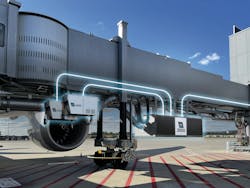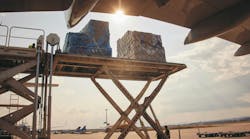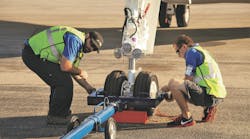Ground handlers have an important role to play in the aviation industry’s mission to reduce carbon emissions.
For the commercial aviation sector to meet its goal of net zero emissions by the year 2050, greener ground services are must. As a result, more focus is being placed on electric ground support equipment (eGSE).
But according to Alberto Rocha, director of sales – the Americas at ITW GSE, airports, airlines and ground handlers face the challenge of not having enough electrical infrastructure to operate the required eGSE and cannot increase available power within their current infrastructure. What’s more, infrastructure enhancements can be too costly to justify.
ITW GSE officials studied these challenges and gathered feedback from its customers to develop its EcoGate solution two years ago.
EcoGate allows users to make gate improvements and increase power capacity with the infrastructure currently in place. Rather than looking at GSE individually, the solution links multiple units of ground support equipment and uses smart solutions to operate that equipment.
The system can be used at existing gates, allowing for improved power usage. And at new gates, EcoGate is designed to be easily installed and with minimal costs.
ITW GSE officials say by utilizing an eGSE ecosystem, new efficiencies can be achieved by having individual pieces of equipment working in unison.
EcoGate was developed through its customer back innovation (CBI) initiative.
“A major airline in the United States presented a challenge to ITW GSE where they needed 400 Hz and PCA with very limited power available,” explains Rocha. “Our goal is to help our customers and the aviation industry overcome the challenge of not having enough power capacity for gate equipment.”
The system provides the power required to ensure GPU and other units have the power necessary to support turnarounds without overloading the total power supply, Rocha explains. EcoGate can also provide power for other projects, when needed, which helps airport and airlines facilitate the use of more eGSE near the gate.
Among the key features of the EcoGate system is the company’s Intelligent Power Management (IPM) solution incorporated into ITW’s 3500 PCA, which Rocha explains provides “power management that achieves energy efficiency and energy savings.”
EcoGate provides intelligent connectivity between various ITW GSE products that share the use of power.
Because PCA units and GPUs often operate with a surplus capacity – sometimes as much as 50 percent, ITW officials say – company engineers developed IPM technology to allocate power where it is needed most. IPM allows units to prioritize the power required without exceeding the gate’s total power capacity, Rocha explains.
IPM monitors the power needed by the GPU and other connected equipment. In the event a unit has a sudden increase in power consumption, IPM technology “borrows” power from the PCA to meet the temporary demand. This allows for continuous power supply and steady comfort for passengers and crew aboard the aircraft.
“The borrowing is so brief, there is no perceptible loss of comfort for passengers and crews,” Rocha says. “And the gate’s total power capacity is never exceeded.”
A common user interface provides ease of use for the operator.
The optional Automated Aircraft Type Detection feature interfaces with the airport video docking guiding system (VDGS) to recognize aircraft and adjust airflow and ground power accordingly. Rocha points out that the exact aircraft is detected as it approaches the gate, not just the category of aircraft.
“The company’s new intelligent hose retriever, Aircoil, has also been integrated into EcoGate,” Rocha adds. “We will also be introducing new products in 2024 that include AC and DC chargers for electric GSE.”
Rocha notes these features working together modernize existing gates and allow for additional EcoGate-enabled GSE to be integrated in the future.
Currently EcoGate is in use at Chicago O’Hare International Airport (ORD), Washington Dulles International Airport (IAD) and George Bush Intercontinental Airport (IAH) in Houston. Rocha says ease of installation and minimized electric infrastructure and wiring have provided key benefits to users.
Feedback has been positive as customers report lower cost of electrical supply and harmful emissions, according to Rocha.
“Very little maintenance is required as our products are electric with solid state components,” Rocha adds. “All ITW GSE equipment complies with industry standard safety requirements.”
Each EcoGate system is customizable to suit an individual project and specific needs. To properly spec GPU and PCA requirements, Rocha recommends defining the type of aircraft that will need to be powered and cooled.
Additionally, it is important to understand and evaluate the electrical infrastructure an airline needs. This way, Rocha notes, the EcoGate system can be properly customized to provide the most efficient way to supply power and pre-conditioned air to the aircraft.






